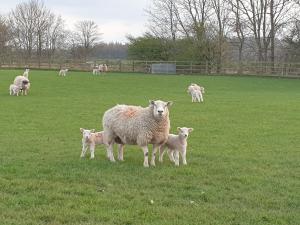
By Vet Shona Mouncey
With the end of lambing time in sight for most, one of the next things to consider in the flock calendar will be when to worm and what with?
Often when we ask this question, the answer is based on habit, convenience as sheep are dosed when already being handled for something else or it looks like it's needing done, by which point the production losses can be high.
With wormer resistance on the rise, our approach needs to be much more targeted to avoid unnecessary treatments.

Nematodirus is usually the first worm which will affect lambs, anytime from 6 weeks of age. Infection is picked up from grazing infected pasture and it is the migrating larvae which cause damage to the lambs' guts.
The results can be a high number of deaths with scour and poor weight gain across the group. This disease can be hard to diagnose as faecal egg counts will not detect it. If you do have any dead lambs and are unsure of the cause of death, postmortems are a useful tool.
To help decide if and when treatment is needed, the main risk factors should be assessed:
High risk pasture - grazing young lambs on the same pasture every year massively increases the risk of Nematodirus. Where possible graze young lambs on ground that didn't have lambs of the same age on it in Spring last year.
Weather - a large hatch classically occurs in warm wet weather following a cold snap. The challenge of a large number of larvae being ingested in a short space of time can lead to severe gut damage quickly.
Age - although outbreaks can be seen in older lambs in Autumn, the classic picture for Nematodirus is in lambs which are 6 - 12 weeks old in Spring.
Parasite forecasts - these look at regional risk to help assess the level of risk in your area.
Clinical signs - ideally based on the other risk factors, treatment will be carried out before clinical signs are seen but if not, as soon as there are any clinical signs of Nematodirus, treatment should be considered.
Reports of wormer resistance in Nematodirus are thankfully low compared to other types of gut worms in sheep. Whilst this means that all classes of wormer should be effective against it, we would recommend the use of a white wormer (Group 1 benzimidazole) as this group is still effective against it and it's use at this time of year will allow you to save the other groups for later in the year when a mixed infection is more likely. As with any wormer, make sure you dose to the heaviest in the group and use calibrated dosing equipment to avoid underdosing.
As we progress into the summer months and (hopefully) warmer, drier weather, the worm burden will become mixed with various worm types present.
The levels of these other worms can be monitored using faecal egg counts which count the number of eggs in muck samples to give a rough idea of the adult worm burden in the sheep itself. This is a great monitoring tool with same day results meaning that you can quickly tell whether treatment for the group is required.
As a starting point, if you haven't done faecal egg counts before, take some samples when you would normally be planning to worm your lambs and go from there.
In general, unless clinical signs appear sooner, monthly checks should suffice. When treatment is required, we recommend that you vary the group of wormer you use, saving group 4 or 5 wormers for a late season "knock out dose", quarantine or where resistance to other groups has been confirmed.